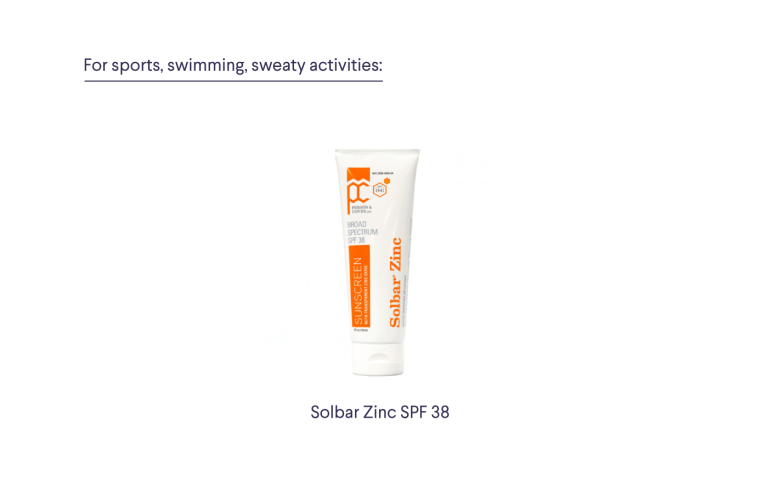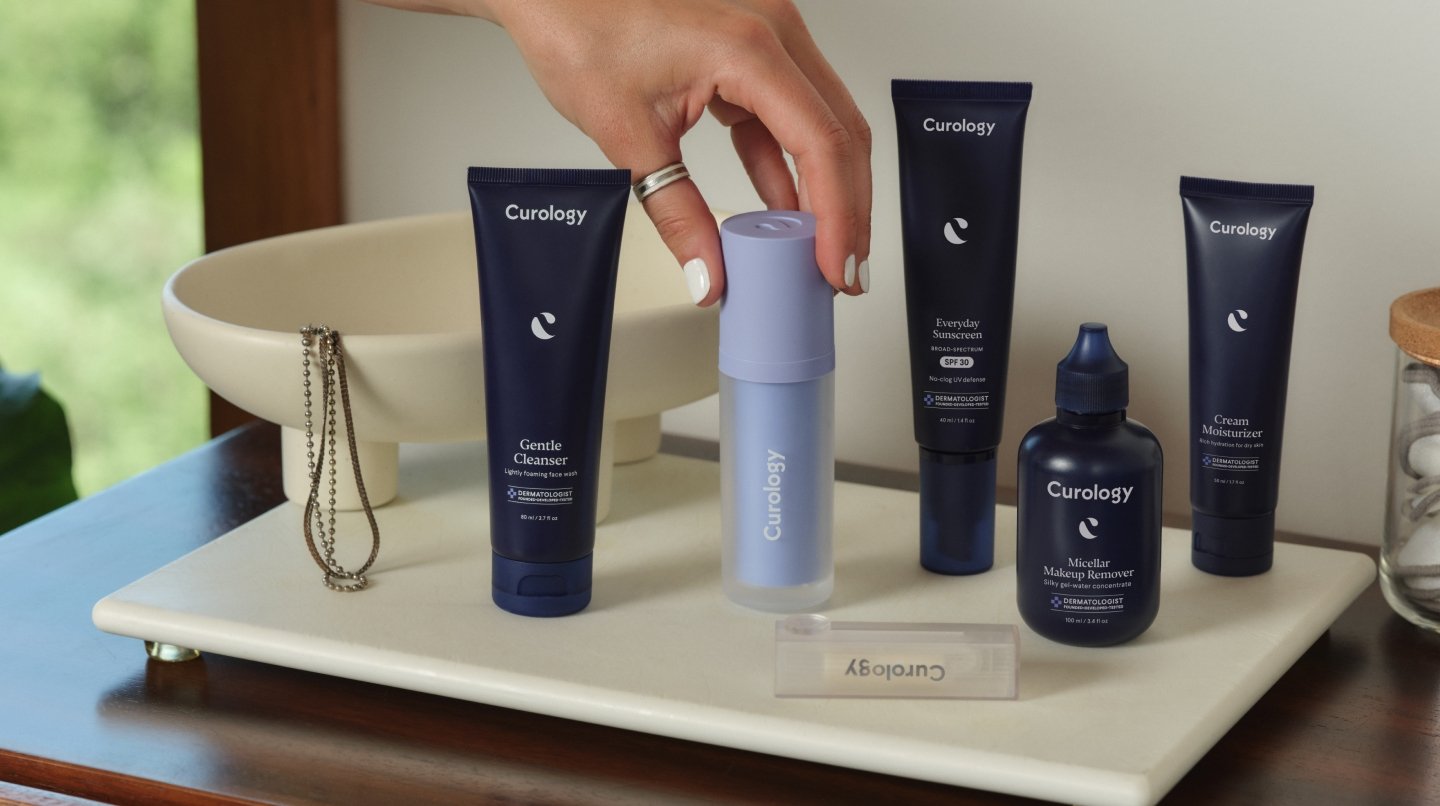How it works:
Share your skin goals and snap selfies
Your dermatology provider prescribes your formula
Apply nightly for happy, healthy skin
How it works:
How it works:
Share your skin goals and snap selfies
Your dermatology provider prescribes your formula
Apply nightly for happy, healthy skin
How it works:
How to choose the best sunscreen for combination skin
Everything you need to know about sunscreen



Sunscreen is the most important skincare step of the day. Combination skin can sometimes be tricky to pick out sunscreen products for —especially if you've got an oily T-zone but are normal or dry on other parts of your face. Some people with combination skin that tends to be oilier can benefit from products made for oily skin.
There are plenty of options to choose from that work great on combination skin, and we’ve rounded them up right here to make it easy to find your new go-to.
Some of the best face sunscreens for combination skin
Most of us with combination skin are well acquainted with clogged pores. To help avoid pore-clogging, take a closer look at the ingredients in any product you use on your skin. We know it’s a lot to remember what all those hard-to-pronounce ingredients really are, though, so here are some products whose ingredients we’ve reviewed to make sure they’re non-comedogenic.

We’ve also reviewed each product in this guide to make sure we stand behind for other reasons, so we’ve eschewed any product whose ingredients may be irritating to sensitive skin. We hope this helps you find your new favorite face sunscreen! Once you’ve found ~*the one*~ don’t forget to wear it and—important!—reapply it. That means every. single. day.
The sunscreen by Curology with SPF 30
A mineral (aka physical) sunscreen with 9.4% zinc oxide
Silky texture and no white cast
Contains hydrating ingredients like squalane and glycerin
Formulated specifically for acne-prone skin by Curology’s team of experts
Supergoop! Smooth and Poreless 100% Mineral Matte Screen SPF 40
100% mineral sunscreen
Two-in-one product also works as a primer
Translucent tinted formula gives skin a smooth, matte finish
Universal tint shade blends into virtually any skin tone
Wear underneath makeup for more coverage, or on its own
FIRST AID BEAUTY 5 in 1 Face Cream SPF 30
Both physical and chemical sun protection
Formulated to help with fine lines and wrinkles, uneven skin tone, and dry skin
Five active ingredients work together to promote a healthy-looking complexion
CoTZ Flawless Complexion SPF 50 - Tinted
Broad-spectrum SPF 50 mineral sunscreens deflect UV rays and helps prevent premature skin aging
Environmentally conscious formula
Non-greasy, non-oily texture
Paula’s Choice PC4MEN Daytime Protect
Broad-spectrum SPF 30 sunscreen with a barely-there feel and shine-free finish
Weightless formula isn’t sticky on skin
Guys: use as the last step in your AM skincare routine
Paula’s Choice Smoothing Primer Serum SPF 30
Multi-tasking primer that softens and smooths skin with a formula that features antioxidants and broad-spectrum SPF 30 for a makeup-ready base
Preps skin for a seamless makeup application
Lightweight, silky texture
Neutrogena Men Triple Protect Face Lotion SPF 20
Helps soothe razor irritation
Hydrates dry skin
Lightweight formula
SPF 20 isn’t enough protection on its own—layer with another sunscreen of SPF 30 or higher
Olay Regenerist Regenerating Face Lotion with SPF 50
Temporarily reduces the appearance of fine lines and wrinkles
Lightweight formula hydrates the skin
Olay Total Effects Face Moisturizer SPF 30
Lightweight hydrating formula
Helps replenish the skin’s moisture barrier
Formulated with anti-aging skincare ingredients
Paula’s Choice Skin Balancing Ultra-sheer Daily Defense Broad Spectrum SPF 30
Lightweight daytime moisturizer with SPF 30
Helps reduce the appearance of shine from excess oiliness
Fluid formula leaves a soft matte finish

Best tinted sunscreen for combination skin
Care for a side of coverage with your sun protection? A tinted sunscreen or tinted moisturizer with SPF is a great two-in-one product: it does double-duty as a lightweight foundation. All you need for an effortless daytime look (complete with sun protection) is a tinted moisturizer with SPF 30 or higher— and yes, there are plenty out there that work with combination skin. The tint helps even out the appearance of your skin tone, and makes things like redness, acne, and pores a little less visible (just add some well-placed concealer, if needed). For more coverage, you can layer foundation makeup on top of tinted sunscreen, then follow it up with concealer on any spots you’d like to hide.
IT Cosmetics Anti-Aging Armour Tinted Sunscreen SPF 50+
Formulated with hydrating and anti-aging ingredients including peptides, niacinamide, hydrolyzed collagen, and hyaluronic acid
Ideal for every skin type with “universal color-correcting pigments”
Protects skin from the sun’s harmful rays with broad-spectrum SPF 50+
IT Cosmetics CC+ Cream Oil-Free Matte with SPF 40
CC cream with a matte finish
Infused with charcoal, colloidal clay, and tea tree extract to help reduce the appearance of oiliness
Clinically tested to help reduce shine and control oil for up to 12 hours
MyChelle Dermaceuticals Sun Shield Liquid SPF 50
Sheer tinted, weightless liquid formula blends easily
100% mineral sunscreen
Helps mattify skin with bentonite to absorb excess oil from pores
Works as a primer under foundation to help create a smooth, matte finish
Oil-free and recommended for all skin types
Paula’s Choice Resist Super-Light Wrinkle Defense SPF 30
Lightly tinted mineral-based formula
Contains antioxidants
Silky texture leaves a soft matte finish
Revision Skincare Intellishade® Original SPF 45
Moisturizes and blends easily for a natural finish
Sheer coverage
SkinCeuticals Physical Eye Uv Defense SPF 50
100% mineral base, broad spectrum UVA/UVB protection
“Non-migrating formula” to help prevent eye irritation
Sheer, universal tint suitable for all skin types
Use from the brow bone to the cheekbone, even on the eyelid
Tarte BB Tinted Treatment 12-Hour Primer Broad Spectrum SPF 30 Sunscreen
A five-in-one longwear, vegan primer that can be used under (or instead of) foundation
Hydrates skin and visibly smoothes fine lines, blurs pores, and gives skin a brightened appearance
Lightweight, sheer coverage
“Triple-B complex” to help brighten, smooth, and soften skin
IT Cosmetics Your Skin But Better CC Cream SPF 50+
Color-correcting formula visibly evens skin tone
SPF 50+ physical sunscreen
Anti-aging benefits with collagen, peptides, hyaluronic acid, antioxidants, and vitamins
Diffuses the look of wrinkles and minimizes the appearance of pores
CoTZ Flawless Complexion SPF 50 - Tinted
Broad-spectrum SPF 50 mineral sunscreen deflects UV rays and helps prevent premature skin aging
Environmentally conscious formula
Non-greasy, non-oily texture
Supergoop! Smooth and Poreless 100% Mineral Matte Screen SPF 40
100% mineral sunscreen
Two-in-one product also works as a primer
Translucent tinted formula gives skin a smooth, matte finish
Universal tint shade blends into virtually any skin tone
Wear underneath makeup for more coverage, or on its own
Looking for the best foundations with sunscreen for combination skin? Check out our makeup guides and our no-breakout makeup series on the blog for our list of products we’ve reviewed to make sure they don’t contain pore-clogging ingredients.

Sunscreen for sports, swimming, and sweating
Not-so-fun fact: there’s no such thing as waterproof sunscreen! In 2011, the FDA released a new set of rules regulating sunscreen in the United States which did away with “waterproof” and “sweatproof” labels on sunscreens because such claims are impossible. (Thank you, FDA, for getting real about beauty claims!) Instead, sunscreens can be labeled “water-resistant” for either 40 minutes or 80 minutes, depending on test results.
That means you swimmers, surfers, athletes, and boogie-boarders need to choose your sunscreen wisely and remember to reapply. Use a water-resistant sunscreen if swimming or sweating, and reapply according to the label instructions, either after 40 or 80 minutes of swimming or sweating, immediately after towel drying, and every 2 hours at a minimum.

Solbar Zinc SPF 38 has an oil-free base that lasts for up to 80 minutes in the water, is more rub-resistant than most, and is gentle on the eyes.
Skincare pro tip: reapply your sunscreen religiously
You and your skin deserve better than to be stingy with the sunscreen, so slather it on liberally and when in doubt, apply more! Most of us don’t use enough sunscreen—the sun’s rays don’t really get boundaries, so make sure any skin in the sun’s line of proverbial fire is fully covered. We know we sound like a broken record by now, but seriously, re-applying throughout the day is essential! Sunscreens need to be reapplied at least every two hours, especially if you’re swimming or sweating.
Use up to a half teaspoon for the face and neck, especially if you use your whole hands to rub in the sunscreen. Use 1 ounce or 2 tablespoons for the body. During a long day at the beach, one person should use around 1/4 to 1/2 of an 8 oz bottle.
No sunscreen, regardless of strength, stays effective longer than two hours. That being said, how often you reapply sunscreen depends on your activities. If you’re inside working all day, no need to reapply. If you’re in and out, reapply at least once midday. If you’re out for extended periods during the day, then reapply every 2 hours or so, especially if you’re entering water, sweating, or wiping your face.

How to layer sunscreen under makeup
Ever try to layer makeup on top of sunscreen, only to have it pill or flake off in annoying little white bits? Ugh! Try applying moisturizer before your sunscreen, then give it a few minutes to dry before putting on your makeup. This should give it enough grip so it won’t flake on you!
How to reapply sunscreen over makeup
Powder sunscreens like ILIA Radiant Translucent Powder SPF 20 are a great, easy way to re-up your sun protection throughout the day without messing up your makeup. Bonus: a little powder will also get rid of any oiliness that’s accumulated on your skin, making your makeup look refreshed while you’re at it.
How to check any product for pore-clogging ingredients
Some common ingredients in cosmetics and skincare products can clog pores or irritate sensitive skin (yes, even if the label says a product is “non-comedogenic” or “gentle”). You can check the acne-causing potential of the products you use by making sure it doesn’t contain the potentially pore-clogging ingredients mentioned here.

When in doubt, custom skincare is what it’s about
If you’re new to Curology, you can try the broad spectrum SPF 30 sunscreen for free* (yes, that’s right!). All you have to do is take our skincare quiz and upload some photos so our dermatology providers can evaluate your skin and prescribe a Custom Formula with the right mix of active ingredients for your unique skincare needs. After a consultation, if Curology is right for you, we’ll send you a 30-day supply of our recommended products—including the face sunscreen. All you have to do is pay $4.95 for the cost of shipping and handling for your free trial of Curology.
Get your personalized skincare routine with Curology
Get your personalized skincare routine with Curology


If you’re an existing Curology patient you can easily add the face sunscreen to your routine—just add it to your next shipment for an additional $14 (plus tax where applicable), and it’ll arrive straight at your door, along with the rest of your custom routine.

Curology Team

Nicole Hangsterfer, PA-C
Related Articles
Peptides for skin: Unpacking their skincare influenceCan turmeric help improve symptoms of rosacea?Foundation makeup for acne-prone skinWhat is pomade acne? How to treat breakouts around your hairlineIs vitamin C good for acne? What you need to knowPopular Articles
Ask Curology: Is my cold breaking me out?Slugging: The dermatologist-approved skincare hack going viral on TikTokTretinoin vs retinol: What’s the difference?How to create a self-care routine that actually sticksYour 2023 skincare horoscopeTry prescription skincare
Get routine essentials

Good skin days ahead
- Breakouts
- Redness
- Fine lines
- Dark spots
- Hair thinning